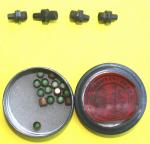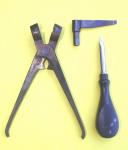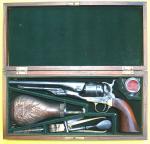-
Posts
13,225 -
Joined
-
Last visited
-
Days Won
22
Content Type
Profiles
Forums
Blogs
Gallery
Events
Store
Everything posted by Mervyn Mitton
-

Unidentified RWAFF collar
Mervyn Mitton replied to Noor's topic in Great Britain: Mervyn Mitton's British & Colonial Police Forces
Timo - I think they were a military force rather then a police one. They wore this badge as a cap badge and as collars. The cap was obviously larger. They are quite common and I would doubt if worth more then about 10 pounds for the cap size. However, prices can vary and you may be lucky. Mervyn -
Peter - this is a very reasonable price - my estimate was a low one. This one that you show is in extremely fine condition for it's age and the paintwork bright. The two interlocking shields are - of course - for the City of London and Brighton. This was made by Parker Field - who were the official armourers to the Metropolitan Police. The Crown is for King William 4th - the brother to George 4th. This is not the one from my collection which was sold to a top collector - however, he may have decided to sell. Mervyn
-
INTRODUCTION We seem to be progressing quite well with the story - and to my surprise seem to have a small following. Episode 3 produced some debate and comment on the Commissioner and the Deputy Commissioner of the Metropolitan Police - this is good and helps to clarify points that might have caused confusion. You have to remember that I just sit down and type as memories return to me - I am bound to have a few lapses. Twenty eight years ago I wrote a book on the History of Policing in England - this was mainly to show the background on the equipment of the past. Whilst there are many Force histories, I believe this still to be the only general one for collectors. http://gmic.co.uk/uploads/monthly_06_2013/blogentry-6209-0-55725500-1371401685.jpgclick I will show a few other pictures at the end. HENDON 1967 The routine continued and now - halfway through the course - it was all coming together and making more sense. The weather had been cold and we had a number of snowfalls - however, the winter uniforms and greatcoat had many years of practical design behind them and were warm and comfortable - just heavy. I mentioned that the exhaustive background checks on new recruits were thorough - but, at first hand I was to see examples of where trainees were already in the system before it all caught-up with them. One of these was in a class further along and his habit of keep disappearing to the Loo caused comment. Both his classmates and the staff noticed and eventually it was found that he was using a drug. Needless to say we never saw him again. I have to be careful with these memories that I don't identify anyone by name - at least, those who had done wrong. I am still bound by the official secrets act - which binds all police officers. However, incidents I mention happened long ago. The other incident was weeks later - we were having our mid-morning break in the canteen when the Chief Superintendent came-in - followed by two military police sergeants. They went straight to the table of a class that was close to graduation and arrested one man. This really took us by surprise - shock ! horror ! probe ! - what had he done ? Turned out he was a deserter from one of the Services. They caught-up with him just in time - he would shortly have been on patrol. When you think about-it - if you managed to join, you would have a fairly good hiding place. I don't think it would be easy and eventually, they would be caught out. I understand that from our original class of twenty, only six were still serving after our two year probationary period. The shift system is not to everyone's liking and certainly limits friends. I think it is why many Police marriages fail - and also, why many go out with and marry, nurses who understood the pressures. SELF DEFENCE We had regular classes showing restraint holds for prisoners - based mainly on wrestling moves. I found in training and later on the streets, that unless they held still I wasn't very good at applying them. My Father had done wrestling as a young man - but even he gave-up on me. The hold that did work for me was to hold their their right arm under my left one and grasp their hand under mine. If they struggled you could exert pressure to immobilise the wrist. When I first went to Division handcuffs were carried around the steering columns of police cars - however,PC's took the keys for themselves and you could never use them. They are now issued - however, I solved the problem by buying my own - saved a lot of struggling. They also instructed us - briefly - on the use of the wooden truncheon. 17 inches overall, (37.5cms) for constables and sergeants - and a shorter version for Inspectors (they were more expendable....) A very effective weapon, they were made from teak, ebony or lignum vitae. All very dense woods that don't float. Nowdays they use the extendable steel baton - which is based on a German WW2 commando version. The only instruction that I remember being told, was never to hit anyone over the head. This is common sense. If your opponent is armed then the best place to strike is the arm holding the weapon. The 'hit' of choice is the collarbone - the arm justs drops. Despite popular myth, most police could do their entire service without drawing their truncheon from the special pocket that ran down the right side. I probably used mine more for breaking windows when looking for people who hadn't been seen for a while. However, I did have occasion - on a number of times - to use it - and will cover those in future posts. I GET INTO TROUBLE We used to get Sundays off and the weekend before we started class 13 , I thought how was I going to get everything back to Bournemouth (100 miles or 160kms) away. I decided to go to Bournemouth by train and bring my car back for the week. I had a TR4A sports car at that time and since the ex-commandant's house had a big parking area - which other people used, I thought it would be OK. WRONG ! I was summoned to the Superintendent's office on the Wednesday. "Why is your personal car parked on Police property - which doesn't have insurance cover for your benefit" ? I was quite 'gobsmacked' - and then something happened which still makes me laugh today. The phone rang - he answered - and it must have been someone senior. He sat up straight with his left arm down his side at the attention position. I have never seen this done before, he was on a phone. After a further lecture he told me to remove the car at once. I replied that if I did , then I would keep driving and he could have my resignation. Shame - I was looking forward to going on duty. He was obviously of the 'old school' and I don't think anyone - particularly not at Hendon - had stood up to him. Reluctantly he told me I was not to resign and could keep the car until I left the following week. Some common sense at last. I think the next chapter will cover my final days at Hendon - and then the first weeks after they released me on an unsuspecting public.................... http://gmic.co.uk/uploads/monthly_06_2013/blogentry-6209-0-24188600-1371404825.jpgclick http://gmic.co.uk/uploads/monthly_06_2013/blogentry-6209-0-03825200-1371404935.jpgclick http://gmic.co.uk/uploads/monthly_06_2013/blogentry-6209-0-52953400-1371405046.jpgclick http://gmic.co.uk/uploads/monthly_06_2013/blogentry-6209-0-19106200-1371405199.jpgclick http://gmic.co.uk/uploads/monthly_06_2013/blogentry-6209-0-62294200-1371405322.jpgclick
-
Peter - I had one of these in my collection until quite recently. They are very rare and marked both the opening of the Railway - and, the accession of Queen Victoria in 1837. Perhaps you will show a picture for it - the heraldic decoration is very elaborate. Value wise - think of around 1000 pounds to a collector. Mervyn
-
The symbol of the clenched fist - to show power and authority - has been used by many different peoples around the World. I agree that this is probably a made-up piece - using something like the safe handle. However, there is just one other possibility - perhaps from a Coat-of-Arms ? Magistrates were usually the local Squire and would have arms. I will look to see in the Landed Gentry book. I hope someone doesn't pay a lot of money for it. With regard to the hollow insides of your other tipstaffs (or, tipstaves - it is a plurality word) - I think this is just to keep them light in weight. Some tipstaffs are hollow to hold a Warrant of arrest - or, a letter of appointment. They are not common but, unfortunately, everyone assumes that is the purpose of a tipstaff. Mervyn
-

Queen's Birthday Honours List 2013
Mervyn Mitton replied to JPL's topic in Great Britain: Orders, Gallantry, Campaign Medals
Thankyou Jean-Paul. -

My Early Police Days - Part 3
Mervyn Mitton commented on Mervyn Mitton's blog entry in Mervyn Mitton's Blog
Wasn't it the reforming Commissioner in the 1970's - Sir Robert Mark - whose book was entitled - 'In the Office of Constable' - or, something similar ? That would indicate a power of arrest. -

My Early Police Days................. Part 4
Mervyn Mitton commented on Mervyn Mitton's blog entry in Mervyn Mitton's Blog
Thankyou for that info. Craig. I hope potential visitors have seen that it is not open to the public.. -

My Early Police Days................. Part 4
Mervyn Mitton commented on Mervyn Mitton's blog entry in Mervyn Mitton's Blog
Thankyou for taking the time to give us these explanations. I had thought that Bow Street had been re-built after it was closed. Considering that there has been a Police Station on the site since the Fielding Brothers had their Court on this site from the 1750's, it would be the ideal place to open a dedicated Met. Police Museum. Easy for visitors to reach. I hope Members have noted the address you have given for the building in West Brompton. Thankyou. -
Spare nipples for the percussion caps + percussion caps http://gmic.co.uk/uploads/monthly_06_2013/post-6209-0-79205100-1370962340.jpgclick
-
-
-
-
-
-
With Percussion cap tin closed http://gmic.co.uk/uploads/monthly_06_2013/post-6209-0-00003200-1370961075.jpgclick
-
Brian recently made a post about 'Iconic Firearms' and many of the suggestions were very interesting. I can't remember if he mentioned this one - however, the New Army .45 1860 revolver must rank highly on any list. Most soldiers in the Union Army carried one. Colt introduced his Navy model in 1851 - actually it was an Army weapon with the smaller bore of .36. The Army model was different in that it was a .45 bore. There were also many other similar weapons of varing sizes and bore. I must tell you immediately , that whilst this is exactly the same as the Colt, it is in fact a copy. Made by a firm called Uberti, it is something to do with Beretta or, Beretti. They are made by the Company in the US and I am totally unable to distinguish it from an original 1860. The name engraving across the top of the barrel is the giveaway. Colt's always say Colt and give the address. This one says .44 New Army Model. Also, on a Colt it will give the Patent number - this one has a block that just says Patent - but no number. This and the English Tranter used a ram rod system to load the percussion chambers - 6 in total. The ammo. chamber is nicely engraved with sailing warships. Value wise I think it is about $400/450 - I think it depends in which Country it is sold. (300pounds) Considering that it has a well fitted case and all accessories - including a bullet mould - I think it is exceprtional value. Being a black powder weapon and a percussion it is exempt from many regulations. Should anyone be interested let me know and I will post it on our For Sale section. http://gmic.co.uk/uploads/monthly_06_2013/post-6209-0-39846200-1370960928.jpgclick
-
Good point Nick I think it looks silly - but, at least he hasn't added a name badge. Maybe he has them in case he gets lost ? When I took my Zulu assistant on my last trip to England I made him carry a note in his top pocket, this said " If found please return to..........." He said he found it very helpful when asking people where he was. Old people used to say " you know your getting old when the Policemen start looking young" . This one to me, looks as if he should still be in school. And, as for the one with the fuzzy hair - good question Paul...............
-
Brian - nice that you moved this post - particularly as Paul has others. Paul - Let's deal with them by order. No.1. With the straight edges to the Crown, probably William 4 (1830/37) or, early Victorian. The shape is quite typical of that time - as is the rounded handle. However, I am a little concerned with the way the brass moulding narrows at the grip end. I am wondering if the original grip was replaced. The wear on the wood is from where it has been put down on tables over 176 years........... Value between 100/250 pounds. No. 2. This is an Inspector's tipstaff for one of the early Forces. It would have been in a leather case that was carried on the belt. The appearance is certainly of the Parker Field style - but without their name I think perhaps made by another company following what had become a generic pattern ? The style of the central ebony grip also looks slightly different. The B3 could be for any town or Force - perhaps Birmingham ? Not having a definite place attribution does keep the price down a little - Perhaps around 300 pounds. No.3. More likely to be C.21 6W. This is probably for one of the early town police. C21 is possibly Constable 21 and 6W - Ward no.6. The District or Ward that he was assigned to. From what I can see of the head it is a Georgian Crown and could date from 1714 to 1830. More likely to be George 3rd. who is our second longest reigning monarch - 1760 - 1820. Value wise I would think 400/500 pounds - again limited by no definite town. No.4. From this inscription it sounds as if Lanarkshire had been divided into three Wards or, Districts to make use of the men available. The person carrying this tipstaff was probably one of three High Constables. This is typical of Scottish tipstaffs - about 4'' to 5'' long (10/12cm) and intended to go flat in the pocket. Sometimes there is a third band in the middle giving the duties of the carrier. You must remember that Constables often carried a tipstaff and a truncheon - so, it may just have been for Constable no. 60 - or, the area covered. I would suggest you make further enquiries in whichever town or County now covers the middle part of Lanarkshire. Probably around 600 pounds - but, this could rise if you find out more about him. I hope this proves of some help - people often wonder why these small items can be worth so much. In most cases there will only be one at any time for a ditrict and often they were handed down to the next constable. When my book was first published we only found evidence of around 2000 tipstaffs - over the years I have heard of other small collections , such as yours, being in existance. I would now put their numbers at around 2500 - but, not more. A tipstaff is an integral part of British law and policing. The purpose was both ceremonial and as a mark of the authority invested in the carrier by the Crown. Like a heraldically painted truncheon , it was necessary for the holder to show it to the person being arrested - or, to whom he was giving instructions. Prior to the 17th Century they are incredibly rare as few people had the right to carry them - and they are usually quite plain. After this many people in authority wanted to carry them and managed to get permission to add them to the 'job'. For personal showing-off they then started having them made of silver, ivory etc.. Assuming that perhaps 50% have been lost over the years - they were always very limited in number. Mervyn
-
Nightbreak - when you first asked I told you that this Baluster type was typical for the towns around Manchester. However, there were other areas that adopted this shape. You will see from the shape of the Crown that it is still the rounded type more common for the Georgian period. Later William 4th. used a style with straight edges - and this was carried over to Queen Victoria. Full marks to Robin for spotting this as an acorn motif - at first glance it does look like a snowflake. This is not a common shape and I think will help identify the area of authority. Where was it that the Charles the 2nd was 'treed' in an Oak when they were searching for him ? A good addition to your collection Mervyn










